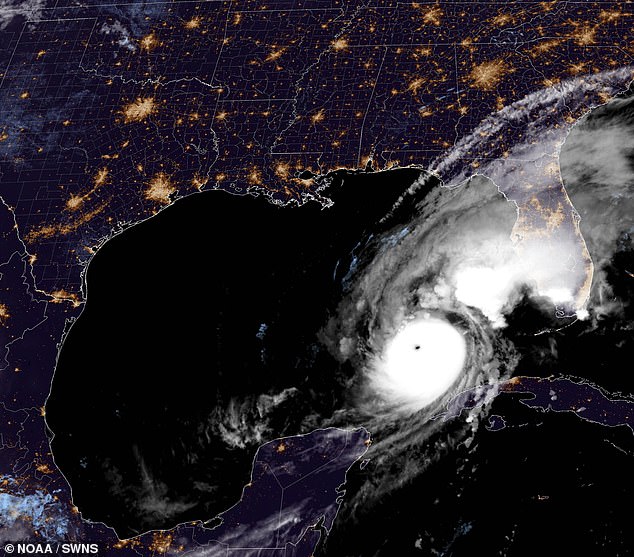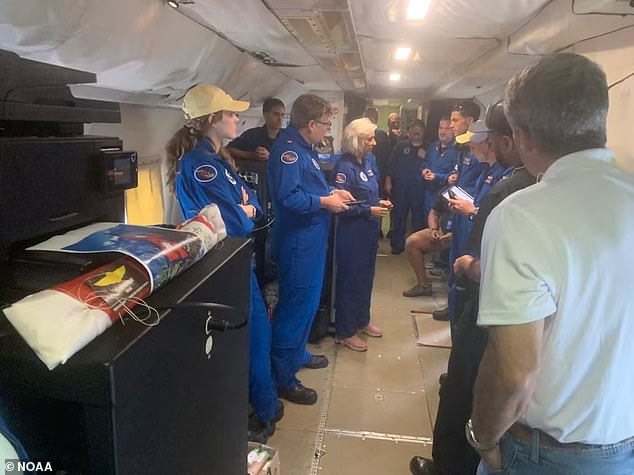Hurricane hunter’s ashes are dropped in eye of storm Milton to mark his final mission
A hurricane hunter who ventured into the eye of 386 storms made one last journey after his death.
The ashes of Peter Dodge, a former meteorologist for the U.S. National Oceanic and Atmospheric Administration (NOAA), were dropped from a plane into the swirling center of Hurricane Milton on Tuesday evening.
Last year, a NOAA obituary reported that Dodge had died “peacefully,” but unexpectedly, on March 3, 2023 at the age of 73, calling it a “sudden and tragic loss.”
Dodge’s ashes were draped in his home state of Florida state flag, were swaddled with his flight suit name tag and a patch denoting the scientist’s hundreds of storm missions.
The scientist’s friend and former boss, Frank Marks, did the honors of releasing the ashes and ended the tribute by recording Dodge’s final flight count at 387 hurricanes.
Above, a photo of Peter Dodge taken by Shirley Murillo for the U.S. National Oceanic and Atmospheric Administration (NOAA) during a hurricane research flight in 2005
According to NOAA, it took an estimated eight minutes for Dodge’s ash to make its swirling descent to the surface of the Gulf of Mexico.
Friends described Dodge as a problem solver whose coding work laid the foundation for much of the radar technology used to study storms today.
Marks recalled many deadly flights with the late meteorologist, including an engine fire while flying into Hurricane Hugo in 1989.
“Peter was unflappable,” Marks told reporters. “That’s the best I can say.”
Marks, who released the ashes during an airborne ceremony attended by a dozen, first met Dodge while interviewing at NOAA in the early 1980s.
Marks said releasing his ashes in Hurricane Milton was “a total honor and a great tribute to Peter and everything he did for us.”
“By releasing its ashes into Hurricane Milton,” as Hurricane Research Division Deputy Director Shirley Murillo said the New York Times‘we tried to honor his memory and his spirit of teamwork, adventure and curiosity.’
Dodge’s courage in the face of the physical risks required to collect the data needed to improve hurricane tracking and modeling earned him one of the highest honors the U.S. government can bestow on a citizen.
Over the course of his career – during which he regularly served as a radar scientist aboard NOAA aircraft – Dodge received a Department of Commerce Bronze Medal, two NOAA Administrator Awards and the Army Corps of Engineers Patriotic Civilian Service Award.
“Peter truly had an unyielding passion for participating in field activities, including flying,” Murillo said, “and an insatiable curiosity for research.”
In his final years at NOAA, after Dodge began to lose his eyesight and was no longer able to fly on hurricane missions, he continued to refine radar programs for the agency, coding using a Braille keyboard.

Above, a NOAA satellite image of Hurricane Milton taken at 3:51 a.m. ET Wednesday – just a few hours after Dodge’s ashes were scattered in the storm at 11 p.m. ET

Hurricane hunters on a mission in Hurricane Milton late Tuesday night (above) honored their fellow meteorologist at the U.S. National Oceanic and Atmospheric Administration (NOAA), Peter Dodge, 73, and dropped his ashes in the eye of the storm at 11 p.m.
Dodge’s fellow Floridians woke up to devastation Thursday after Hurricane Milton hit the state’s Gulf Coast near Sarasota, south of Tampa Bay, leaving several dead and 3 million people without power.
The powerful storm weakened to a Category 3 hurricane before making landfall, but was powerful enough to clear the entire Florida peninsula and still classify as a Category 1 hurricane.
The storm, which grew from a tropical storm to a hurricane of historic severity, spawned a series of tornadoes in its wake, killing at least four people in St. Lucie County, the Sheriff’s Office said.
Extreme storms like the one in Milton may seem unprecedented, but as we enter a new climate reality, it may be time to “set that term aside,” as historical geographer and hurricane hazards expert Craig Colten told DailyMail.com.
“With a warmer climate, a storm like Helene or Milton is the new precedent,” he said.
Until his death last year, Dodge worked tirelessly to better understand, track and predict how hurricanes behave and evolve.
The NOAA researcher contributed code, even as his vision deteriorated over time, to flight modules for hurricane landing experiments and coordinated with research teams to collect data from mobile weather platforms.
“He loved what he did,” Marks said the Washington Post. “I don’t think he could think of anything else.”
Florida residents seeking assistance are urged to call the State Assistance Information Line (SAIL) at 1-800-342-3557 and/or the FEMA Helpline at 1-800-621-3362.
